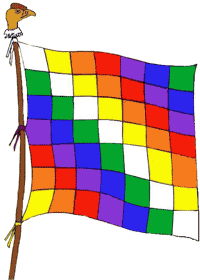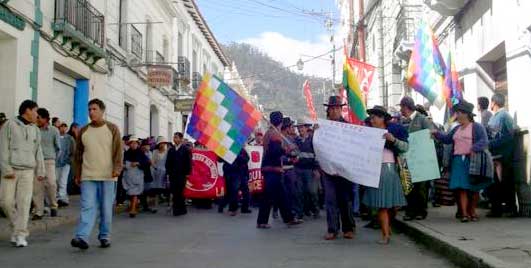13 June 2005
The Wiphala
The Wiphala (from the Aymara word meaning “flag”) is a square shaped flag consisting of forty-nine small squares in a seven by seven grid, in the colors of the rainbow graduating from the brightest to the palest.
The flag is a symbol of the Aymara people, and recently, of the Aymara uprising in Bolivia. It has also become a symbol in the broader iconography of pro-indigenous movements in Ecuador, Peru, Bolivia, and Chile.
The origin of the design is uncertain. It is attributed the ancient Tiwanaku state. However, despite the indigenous aesthetic resonances of the unusual square pattern and multicolor geometry, it is most likely of modern origin. Although pre-Columbian towns of the Andes did not lack their own symbols (particularly those with a state tradition, like the Inca), the format of quadrilateral textile banner to wave in the wind is a tradition of the Old World.
Archaeological fragments from antiquity support the thesis that it may a “rescued” old symbol, as with the Chakana or Andean cross. It is possible that the modern origin of the Wiphala (without discarding the hypothesis of its Tiwanaku roots) is related to the design of modern flag of the Cusco (rectangular with seven horizontal strips with the colors of rainbow), which many claim to be a flag of the Incas.
Rainbow patterns were used in several symbols of the Tiwanaku state, but it is not documented in the form of a flag — while other formats of indigenous state symbols have been found.
 However, Aymara textile read as a symbol is not completely unheard of. In 1534, during the Spanish invasion and occupation of Cuzcu, the Spaniards found among the resistance a multitude of objects similar to the striped flag and and other iconography with the of seven colors of the rainbow. The Wiphala was banned, considered politically subversive by the governing elite.
However, Aymara textile read as a symbol is not completely unheard of. In 1534, during the Spanish invasion and occupation of Cuzcu, the Spaniards found among the resistance a multitude of objects similar to the striped flag and and other iconography with the of seven colors of the rainbow. The Wiphala was banned, considered politically subversive by the governing elite.
The great explosion in the use of the Wiphala coincides with the rural mobilizations and indigenous movements in Bolivia in the 1970’s. It has since become a recognizable Amerindian symbol in the political struggles of the indigenous nations of the American continent. In Bolivia, the Wiphala is visible in all kinds of public demonstrations, political actions, and civil resistance by the Aymara and Quechua population.
Civic use of the Wiphala in the daily life of indigenous communities has also grown enormously. It has become an Andean custom to hoist the flag at social and cultural events, ceremonies, and celebrations.


